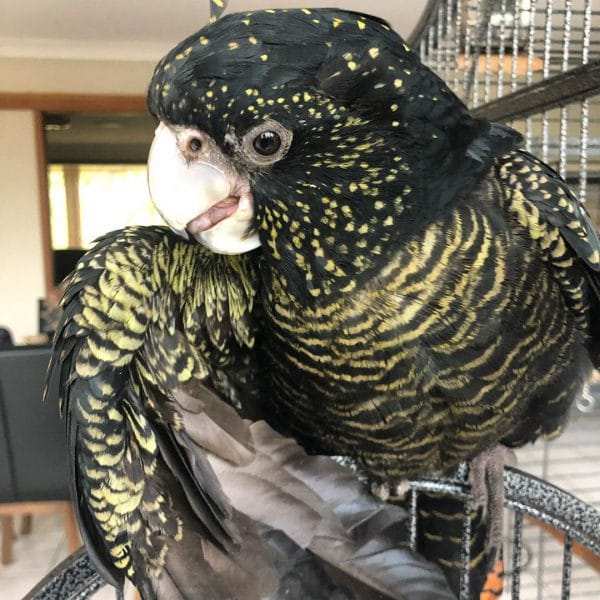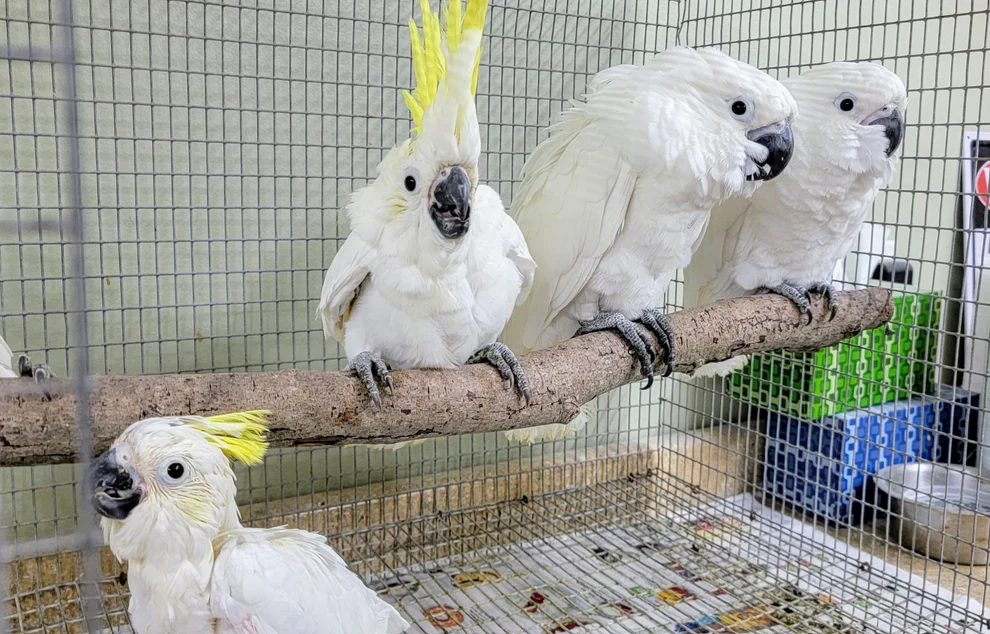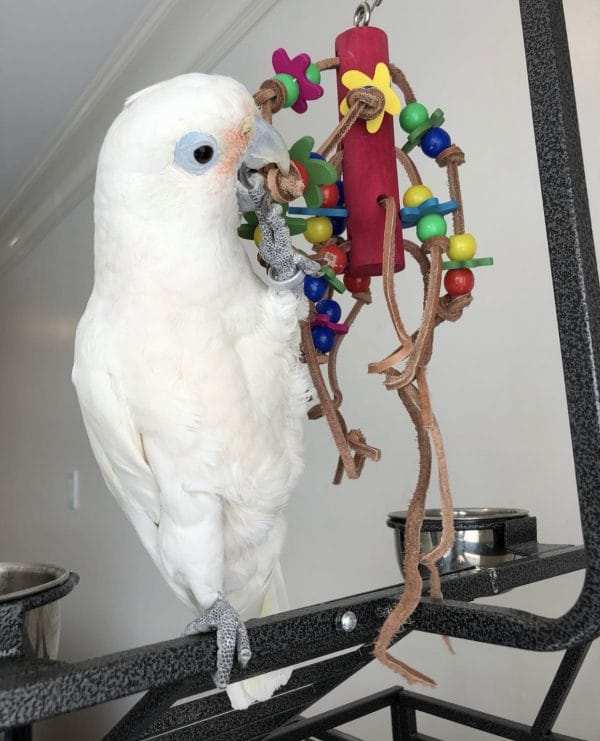Types Of Cockatoo
Cockatoos are affectionate birds known as “velcro birds” because they love spending time with their caretakers. They are members of the parrot family, and there are several types of cockatoo commonly kept as best birds for kids. However, they aren’t the easiest birds to care for because they require lots of attention, can be noisy, and, if neglected, can become depressed and ultimately resort to destructive behaviors.
Despite the obstacles of living and caring for types of Cockatoo, they are beautiful and loving creatures that have an attractive plumage. With the right care and attention, they can become your best companion. Here are 10 of the most popular pet cockatoo species to consider having as a pet.
Gang Gang Cockatoo
Sally – Tanimbar Corella Cockatoo
Rico – Corella Cockatoo
Mercy – Red Tailed Black Cockatoo
Luna – Solomon’s Cockatoo
Layla – Yellow Crested Cockatoo
Darla – Cockatiel Cockatoo
Bradley – Yellow Tailed Black Cockatoo
Blaze – Salmon Crested Cockatoo
Archy – Caparrotua Cockatoo Parrot
Angel – Glossy Back Cockatoo Parrot
Triton Cockatoo Parrot
Slender Billed Cockatoo
Ducorps Cockatoo Parrot
Lesser Sulphur-Crested Cockatoo
Bare Eyed Cockatoo
Paris – White Cockatoo
Rocky – Sulphur Crested Cockatoo
Major Mitchell’s Cockatoo
Black Palm Cockatoo
Rose Breasted Cockatoo
Bare-Eyed Cockatoo
The bare-eyed types of Cockatoo might not be the prettiest parrot, but it makes up for it in personality. Sweet, playful, and intelligent, these best birds for kids are smaller than many cockatoo species. This makes them a good option for families with children and those who lack the space to accommodate a large parrot.
Species Overview: Goffin’s Cockatoo
- Length: 14 to 17 inches
- Weight: 11 to 16 ounces
- Physical Characteristics: Primarily white plumage with a subtle pink blush around the face, a gray-tan beak, and distinctive gray-blue eye rings.

Black Palm Cockatoo
The bare-eyed cockatoo might not be the prettiest parrot, but it makes up for it in personality. Sweet, playful, and intelligent, these birds are smaller than many cockatoo species. This makes them a good option for families with children and those who lack the space to accommodate a large parrot.
Species Overview: Black Palm Cockatoo
- Length: Approximately 23 inches
- Weight: 32 to 42 ounces
- Physical Characteristics:
- Plumage: Smoky gray feathers with a soft, slightly pinkish or salmon hue
- Crest: Prominent, long crest that can be raised when the bird is excited or alert
- Feet and Beak: Gray
- Distinctive Markings: Red patches on the cheeks that stand out against the gray feathers

Citron Cockatoo
Citron cockatoos are quieter than most cockatoo species. However, they have big personalities and love to play and interact with their caretakers. Inquisitive and affectionate, a citron cockatoo will want to be by your side all day long. Be prepared to spend several hours per day with this bird.
Here’s an overview of their typical characteristics:
- Length: 14 inches
- Weight: Approximately 16 ounces
- Physical Characteristics:
- Coloration: Mostly white feathers with distinctive orange patches on the cheeks.
- Crest: Vibrant orange crest, which can be raised or lowered depending on the bird’s mood.
- Wings and Tail: Hints of yellow under the wings and tail, adding a subtle contrast to their predominantly white plumage.
- Beak and Feet: Gray-colored, robust beak and sturdy feet suitable for gripping branches and climbing.

Sulphur-Crested Cockatoo
Sulphur-crested cockatoos are highly intelligent and need plenty of space to play. Unless these birds are given adequate exercise and mental stimulation, they might resort to behaviors such as feather picking and destructive chewing. Caretakers must provide their birds with plenty of toys and several hours of attention each day.
Species Overview: Sulphur-Crested Cockatoo
- Length: 15 to 20 inches
- Weight: 12 to 31 ounces
- Physical Characteristics:
- Coloration: Primarily white feathers with a distinctive yellow crest that they can raise and lower.
- Beak: Black, strong, and suited for cracking nuts and other tough foods.

Goffin’s Cockatoo
Goffin’s cockatoos require as much daily socialization as possible for their emotional health. These birds simply cannot thrive if they are neglected and will resort to destructive behaviors if their social needs aren’t met. Because they are intelligent and slightly mischievous, these birds are recommended for people who have experience with large parrots.
Species Overview: Goffin’s Cockatoo
- Length: 13 inches
- Weight: 8 to 14 ounces
- Physical Characteristics:
- Coloration: Primarily white, with subtle pink near the sides of the beak and crest
- Underwings: Yellow feathers that can be seen when the bird is in flight
- Feet and Beak: Gray
- Personality: Goffin’s Cockatoos are known for their intelligence and playful nature, often described as curious and affectionate, though they require attention and mental stimulation.

Major Mitchell’s Cockatoo
The Major Mitchell’s cockatoo is an attractive and intelligent bird that is known for its colorful crest. While they are a sight to see, these cockatoos need specialized care and large enclosures that not all people can accommodate. They also are recommended for those who are familiar with large parrots.
ajor Mitchell’s Cockatoo
- Length: Approximately 14 inches
- Weight: About 15 ounces
- Physical Characteristics:
- Color: Primarily pinkish-white
- Unique Markings: Pink patches around the neck, underbelly, and under the wings
- Crest: Stunning pink and yellow-orange crest with white tips, which they raise when excited or alarmed
Behavior and Habitat
- Habitat: Typically found in arid and semi-arid inland regions of Australia.
- Behavior: Known for its playful nature, Major Mitchell’s Cockatoo is social but can be shy around humans. It forms strong bonds with its mate and is typically observed in pairs or small flocks.

Moluccan Cockatoo
Black palm cockatoos are large, powerful birds that require a caretaker with ample parrot experience. While hand-fed black palm cockatoos can make excellent pets, they still require firm training to keep them tame. These are bold parrots that need bold owners who aren’t intimidated by that massive beak.
Moluccan Cockatoo Overview
- Length: Approximately 20 inches
- Weight: Around 30 ounces
- Physical Characteristics:
- Plumage: Primarily white with a slight salmon-pink hue
- Crest: Pink feathers at the base, giving it a distinct look when raised
- Underwings: Yellow to peach feathers, adding a subtle color contrast
- Beak and Feet: Black, which stands out against the lighter plumage

Cockatoo Behavior
Each types of Cockatoo has their own personality, and while some can be affectionate, even “cuddle-able,” especially as babies, others can be very aggressive and prone to biting once they become sexually mature after about 5–7 years of age. In general, however, cockatoos are known for their ability to bond with their people. And while this trait may be wonderful in a pet, it often leads to the development of separation anxiety in these birds.
Vocalization
The biggest factor in owning a cockatoo, perhaps, is the noise. While most cockatoos won’t mimic many words spoken by their pet parents, they still squawk very, very loudly. This is not only damaging to hearing, but incredibly stressful to the pet parent and neighbors. Think twice about a cockatoo if you are in a living situation that’s not conducive to this level of noise.
Excessive loudness or screaming may be mitigated if a pet parent sets proper boundaries with the bird as a baby. Providing the bird with outlets to expend excess energy, as well as adequate mental stimulation, also helps.
If your best birds for kids becomes very loud, don’t inadvertently reward the screaming by acknowledging it (yelling back at the bird to stop, for example), coming back into the room (which reinforces bad behavior), or by punishing the bird for screaming. Birds are loud by nature and won’t understand these consequences.
If your cockatoo is producing unusual sounds, visit an exotic/avian veterinarian to confirm there isn’t a medical issue.
Types of CockatooFeather Plucking
It’s common to hear stories of best birds for kids plucking their feathers—often completely off, down to bare skin, and sometimes even mutilating the skin. Illnesses can often contribute to development of feather picking, as well as inappropriate care or improper socialization. Pet parents should contact their veterinarian with any concern about their bird feather plucking.
Separation Anxiety
Because a bird’s pet parent is the one providing food, attention, and social interaction, some birds can develop an abnormally close bond with their pet parents. Overly attached types of Cockatoo may see their pet parents as their mates, which can lead to the development of separation anxiety, territorial aggression, and sexual frustration manifested in problem behaviors such as feather picking, self-mutilation, biting, and screaming.

























